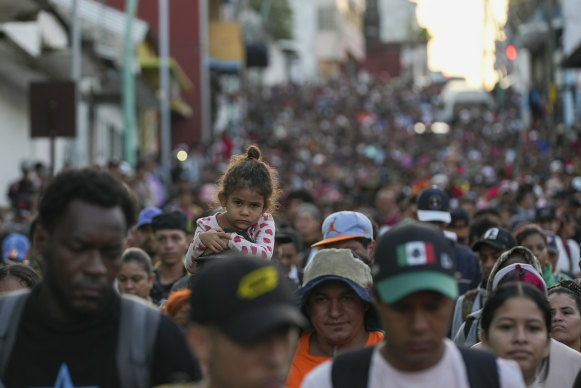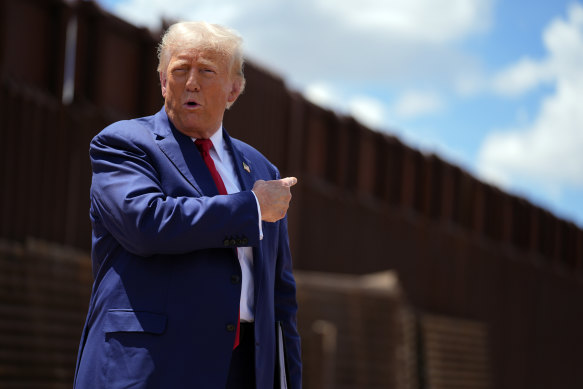This was published 8 months ago
Trump weaponised the border crisis to get elected. Now he must deliver
A 12-year-old was raped and killed by illegal immigrants. Her mother’s pain served as an illustration for Trump’s signature policy. But will he succeed in deporting 11 million people?

Donald Trump on a tour of the southern border with Mexico meets Alexis Nungaray, mother of Jocelyn, who died at the hands of illegal immigrants, and Joamel Guevara, who holds a shirt with a photo of Jocelyn.Credit: AP
Alexis Nungaray had no idea that June 16 this year would be the last time she would see her 12-year-old daughter.
The Texas mother remembers going to bed that Sunday night and telling Jocelyn – her “spunky, quirky, funny” child – how much she loved her.
She remembers, too, the feeling of dread when she woke up the next morning to discover Jocelyn missing, followed by the realisation that her mobile phone, which had a location finder on it, was pinging at the skate park about two minutes away from their house.
But what haunts Nungaray the most is arriving at the park to the sight of police officers and yellow tape cordoning off the area, which was now a crime scene.
As she would eventually find out, Jocelyn had gone to buy a drink from a corner store, where she was preyed on by two illegal immigrants from Venezuela, 26-year-old Franklin Jose Pena and 22-year-old Johan Jose Rangel Martinez.
Both were charged with rape and murder, after Jocelyn’s strangled body was discovered in a creek: her hands and ankles bound, her pants missing.
“Kamala Harris was in charge of immigration in our borders,” the softly spoken Alexis Nungaray says on a powerful and haunting video Donald Trump would play at his rallies as election day neared.
“Under her being vice president of this country, my daughter’s life was ripped away from her.”
It’s tragedies like these that helped to make the US immigration crisis such a defining feature of Trump’s election-winning campaign – and such an insurmountable challenge for Harris.
After coming to office in 2016, vowing to build a wall at the US-Mexico border and branding all illegal immigrants as rapists and murderers, the former president doubled down on the themes as he sought to return to the White House.

A migrant strikes a pose as he walks alongside the highway in Escuintla, southern Mexico, heading towards the country’s northern border and ultimately the United States last week.Credit: AP
Illegal immigrants were “poisoning the blood of our country”, the incendiary Republican would falsely declare. They were “stealing Americans’ jobs”; “eating pets”; “coming from jails and mental institutions”; and “killing Americans en masse”.
And just as the Biden-Harris administration was to blame for not cracking down on the border crisis soon enough, Trump insisted that he had the solution: the biggest mass deportation program in US history to get rid of undocumented immigrants.
“They’re going to go back to their countries because there is no staying here,” the president-elect said last week.
But as the dust settles on Trump’s emphatic victory, there are fundamental questions about how, exactly, the US could possibly carry out the largest law enforcement operation in history – and at what cost.
After all, there are an estimated 11 million undocumented immigrants living in America: foreign-born people without a valid visa or other immigration documentation because they entered the US illegally, stayed longer than their temporary visa permitted, or otherwise violated the terms under which they were admitted.

Migrants from various countries depart Tapachula, Mexico, on election day, hoping to reach the country’s northern border and ultimately the United States.Credit: AP
But contrary to the narrative Trump pushed, the vast majority are not violent criminals but workers in sectors such as agriculture, construction and hospitality, and adding to the economy as consumers and taxpayers.
About 5.1 million children became American citizens at birth but live with an undocumented family member in what is known as a “mixed status family”.
Experts warn that separating them could not only lead to economic hardship, it could also result in emotional stress for all involved.
“There’s a significant amount of fear and a significant amount of concern,” says Juan Proano, the chief executive of the League of United Latin American Citizens, the nation’s oldest Latino civil rights organisation.
“We understand that we need to stem the flow of migrants coming into this country, but you need to separate out two different issues: which is the inflow of migrants, and then, essentially, what would be an interior issue: immigrants that have been here for 10, 20 or 30 years.”
As for the financial cost? While Trump told NBC last week that “there is no price tag” for his signature policy, an analysis by the American Immigration Council suggests a one-time mass deportation program would have a “devastating” bill of at least $US315 billion ($474 billion).
A longer-term operation – which would involve arresting, detaining, processing and deporting about 1 million people each year – would cost about $US88 billion annually, or a whopping $US967.9 billion over more than a decade.

Stephen Miller, former White House senior adviser for policy, speaks during a Trump campaign event.Credit: Bloomberg
Muzaffar Chishti, a senior fellow at the Migration Policy Institute in New York, says implementing the signature policy won’t be easy but it wouldn’t be the first time Trump came to office with immigration promises he struggled to keep.
In 2016 the Republican candidate pledged to build a “giant wall” – paid for by Mexico – that would span the entire 3145-kilometre stretch of the southern border, which cuts across California, Arizona, New Mexico and Texas.
Eventually, only 737 kilometres was built, mainly to replace smaller, dilapidated sections built by previous governments, and Mexico did not contribute.
Chishti reckons Trump will nonetheless want to show that he is making good on the pledge, and predicts that “there will be some high-profile removals: someone being carried off in handcuffs, people with orange suits, rapists and murderers being arrested – which, by the way, is done every day in our government”.
But, he adds, in reality a mass deportation program will face its share of hurdles, from the pushback of Democratic governors and legal challenges from groups such as LULAC and the American Civil Liberties Union, to the sheer logistics involved.
It is also unclear how people will be deported if the US does not have agreements in place with the country of origin.

Donald Trump speaks on the southern border with Mexico in August. Only a fraction of his “beautiful wall” was built during his first term – and mainly to replace older dilapidated sections.Credit: AP
“Firstly, these people are living in communities all across the country, so to get them you’ll need either permission of people to get into their house or you’ll need a warrant,” he explains.
“Secondly, even if they arrest people, we still have the bedrock constitutional principle of Habeas Corpus – where every person gets the right to go to a federal district court judge and request to be released.
“And even if we assume that a judge says someone can be arrested, you can’t just physically remove someone unless you have a Final Order of Removal – and for that you need an immigration hearing in a court system that already has a backlog of about 3.7 million cases.”
As the president-elect moves to consolidate power in the White House by filling his administration with loyalists, Trump announced this week that his former adviser Stephen Miller – a far-right nationalist known for stoking racist conspiracy theories about white people being replaced by immigrants – would return to Washington as his deputy chief of staff and top Homeland Security aide.
Former Immigration and Customs Enforcement (ICE) acting director Tom Homan was appointed “border tsar”, which Trump said would put him “in charge of all deportation of illegal aliens back to their country of origin” and give him oversight of the southern border, the northern border, all maritime, and aviation security.
And South Dakota Governor Kristi Noem – who made headlines this year after she bragged in a book about killing her puppy – was nominated to head the Department of Homeland Security.
The appointments are indicative of how Trump plans to approach what is likely to be a seismic shift in immigration policy over the next four years.
Noem being someone with no experience working in a federal department or in law enforcement, observers view her elevation as a sign the administration’s immigration policy will be run out of the White House by Miller and Homan, leaving the gun-loving governor to focus her efforts on the many other agencies within Homeland Security, including the Secret Service, the Federal Emergency Management Agency, and Transportation Security Administration.
But some view this as an ominous sign in itself. Miller, after all, is the architect of Trump’s deportation plan, and has previously said that a second Trump administration would seek a tenfold increase in the number of deportations to more than 1 million a year.
Outlining how the policy might work at a Conservative Political Action Conference this year, Miller said the first objective would be to “seal the border – no illegals in, everyone here goes out”.
The second would involve establishing “large-scale staging grounds” where “you grab illegal immigrants and then you move them to the staging grounds where the planes are waiting for federal law enforcement to remove those illegals home”.
Homan, meanwhile, worked for Trump’s first administration and was one of the top advocates of its controversial family separation policy.
This separated more than 5500 children from their immigrant parents at the US-Mexico border in 2018 under the short-lived “Zero Tolerance” approach. According to the Department of Homeland Security, 1401 of those children had still not been reunited with their families as of April.
Homan indicated that he would not seek to reinstate that policy, but rather that families could be “deported together”.
“We will prioritise public safety threats and national security threats first and that’s where the focus will be.” After that, he would seek to target non-criminal immigrants in the country illegally.
But this has always been where the focus lies – including under the Biden administration.
According to research conducted by the Migration Policy Institute, when you combine deportations with expulsions and other actions to block migrants without permission entering the US, the Biden administration had almost 4.4 million repatriations in a single term – more than any single presidential term since the George W. Bush administration.
Nonetheless, the crisis at the border is real. Indeed, since Biden took office in January 2021, there have been about 10.7 million illegal immigrants detained or intercepted – not just from Latin America but also from Asian, African and Middle Eastern nations – thanks in part to the president’s decision to rescind Trump-era policies as soon as he entered office.
Among them was the scrapping of Trump’s border wall, as well as a policy that required asylum-seekers to wait in Mexico for an immigration court hearing in the US.
Border agents have encountered 1700 people on the terror watch list since 2021 (all but 367 arrived through legal points of entry) and more than 22.6 tonnes of fentanyl came over the border last financial year alone.
Harris tried, albeit unsuccessfully, to argue the Biden administration wanted to fix the problem through a bipartisan bill that would have enhanced law enforcement, sped the asylum process for valid claims, and required the border to be closed if encounters reached a daily average of 5000 in a week or 8500 on a single day.
“But you know what happened to that bill?” she said during the presidential debate.
“Donald Trump got on the phone, called up some folks in Congress and said, ‘Kill the bill’. You know why? Because he’d prefer to run on a problem instead of fixing a problem.”
It ended up being an election-winning strategy.
Get a note directly from our foreign correspondents on what’s making headlines around the world. Sign up for the weekly What in the World newsletter here.